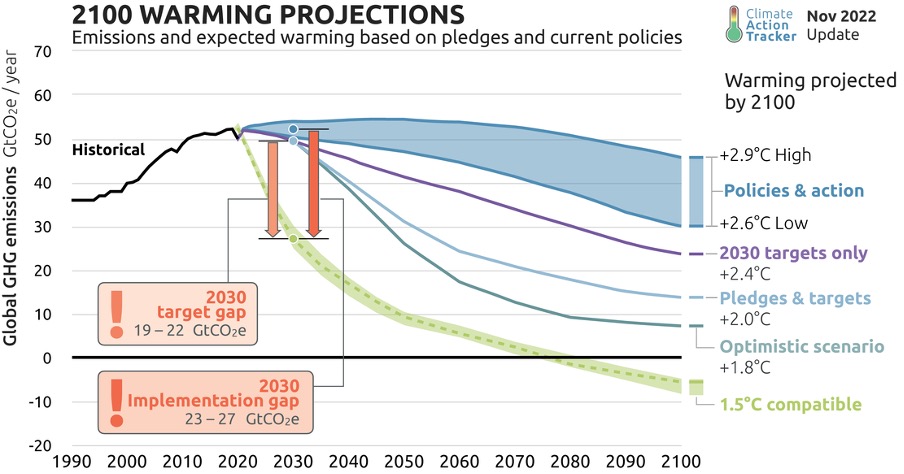We are heading towards a 1.8 – 2.7°C world
In 2015, the Paris Agreement was established as part of a UN Framework Convention on Climate Change (UNFCCC), which 165 member states ratified. As a result, the member states submit their nationally determined contributions (NDCs) to climate change mitigation with respective climate policies and pledges.
Unfortunately, current climate change mitigation policies and climate pledges are insufficient as the world is heading towards outcomes between 2.0 and 2.7°C global warming by the end of the century.
According to the assessment by Climate Action Tracker in its briefing in November 2022, the most optimistic scenario aims at a temperature increases of approximately 1.8°C . It states that the UN Climate Change Conference COP26 and the associated process of updating NDCs “failed to deliver the urgent emissions cuts governments promised to deliver to keep warming to 1.5°C”. This scenario assumes an implementation of net zero targets by 140 countries, which would still not be compatible with the Paris Agreement. Consequently, we are far off track of limiting global warming to 1.5°C.
Net zero by 2050 or sooner and halve global emissions by 2030
To enter on a 1.5-°C compatible decarbonization pathway, we need to achieve four important goals:
- Phase out fossil fuels,
- halve global emissions by 2030,
- reach net zero emissions by 2050 or sooner and,
- keep the emission budget for 1.5°C
The IEA report Net Zero by 2050 outlines that with their 1.5°C decarbonization pathway, “no new oil and gas fields (are) approved”. A further analysis by the International Institute for Sustainable Development found that there is a large consensus “that developing new oil and gas fields is incompatible with the 1.5°C target”. Additionally, fossil fuels must be phased out to advance the decarbonization of the economy and be substituted with low-carbon alternatives, such as renewable energy.
Furthermore, to enter on a 1.5°C compatible pathway, the global CO2 emissions need to be halved by 2030. Therefore, an urgent implementation of global emission reductions is necessary. The aim is to achieve net zero emissions by 2050 or sooner, where global emissions are reduced to nearly zero and remaining emissions are neutralized through permanent carbon storage.
The entire process must stay within the defined CO2 emission budget of 1.5°C. The longer the decarbonization of the economy is delayed, the more of the budget is consumed.
The most recent Emission Gap Report by the UN Environment Programme outlines that there is a gap between where the world is headed and where it should be considering global CO2 emissions. This ambition gap outlines that global CO2 emissions would need to be reduced to approximately 33 GtCO2e to be on a pathway compatible with limiting global warming to 1.5°C. Existing pledges need to be swiftly implemented and additional climate action is urgently needed.
COP27 – after COP is before the COP
The UN Climate Change Conference in 2022 was held in Sharm-El-Sheik, Egypt. The Conference of Parties 27 (COP27) is the decision-making body regarding implementation of the above-mentioned climate change convention UNFCCC. Compared to the previous COP26 in Glasgow in 2021, the above-mentioned Emission Gap report outlines that 2022 was a “wasted year” and the updated NDCs did very little for climate action with pledged emission reductions. COP27 would have had to deliver unprecedented emission cuts to decarbonize all economic sectors, from electricity, industry, transport, and buildings, however, it failed to deliver.
Moreover, the final declaration did not include the relevant aspect of phasing down fossil fuels. This presents a significant setback to global climate action and maintain chances to limit global warming to 1.5°C. A positive outcome of COP27 was the implementation of a “loss and damage fund”, where member states would help alleviate the incurred costs of climate change some countries are increasingly likely to bear.
The role of financial institutions in allocating capital for a low carbon transition
The UN Environment Programme estimates that a transition to a low carbon economy requires annual investments of at least 4-6 Trillion USD, only 1.5-2% of assets under management but 20-28% of annual resources. The financial system plays a key role of facilitating this transition by steering financial flows towards low carbon technologies and solutions.
Already at the UN Climate Change Conference COP26 2021 in Glasgow, a large alliance of financial institutions, the Glasgow Financial Alliance for Net Zero, committed to transition their portfolios to net zero by 2050 or sooner. The alliance brought together commitments by asset owners, asset managers, banks, and insurers, totaling over USD 130 Trillion. While the pledges are a significant first step, implementation and as a result decarbonization becomes key.
What does radicant do?
Together with over 600 investors, radicant has signed the “2022 Global Investor Statement to Governments on the Climate Crisis”, calling governments to raise their ambition regarding climate action and “enable large scale zero-emissions, climate-resilient Investments”. The statement includes several asks for governments to align their NDCs with 1.5°C and other measures to facilitate the transition to a low carbon economy. Building on its SDG-aligned investment approach, radicant has developed its radiTheme Climate Stability, which allows investments into companies that provide solutions towards the achievement of the Sustainable Development Goals (SDGs), specifically SDG7, SDG 11 and SDG13.
- Read about climate change in our first part.
- More information about the radiTheme Climate Stability.

 2100 Warming Projections. Source:
2100 Warming Projections. Source: